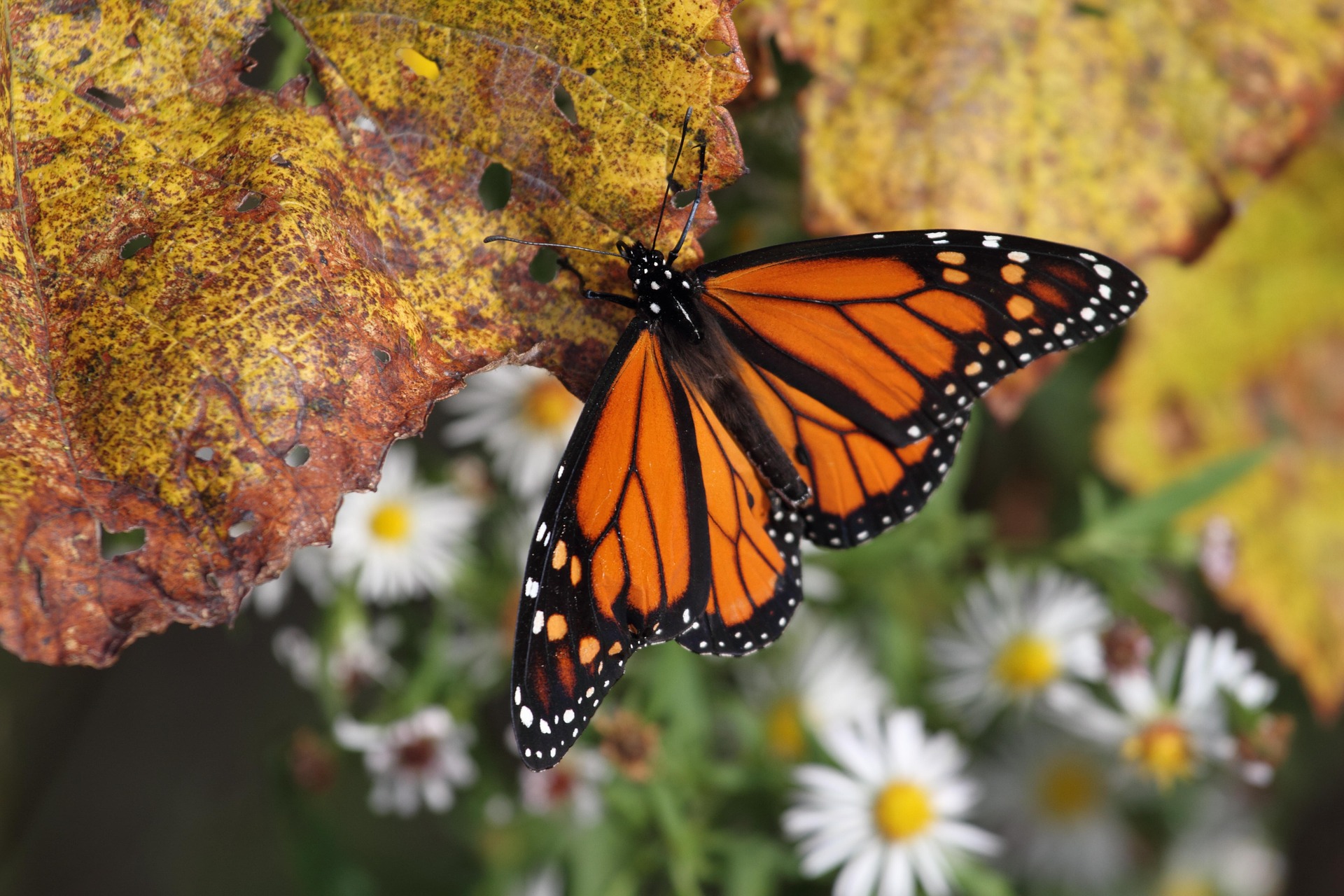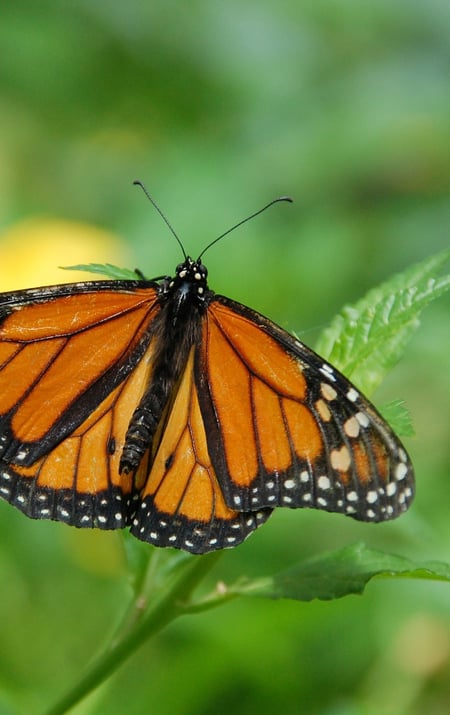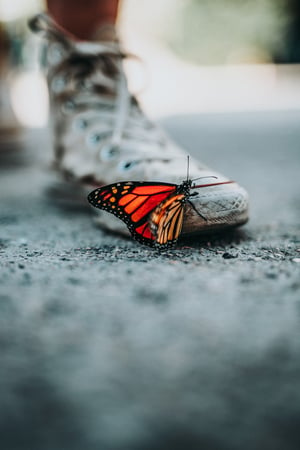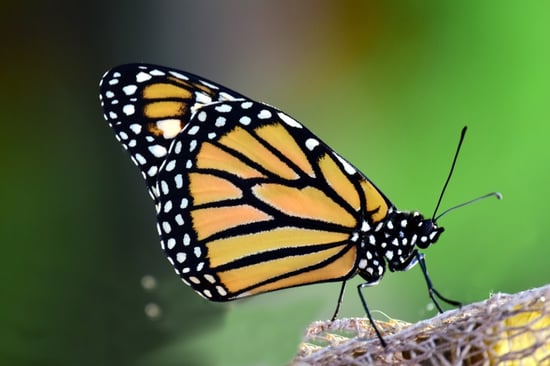
The monarch butterfly is a threatened species that serves as a litmus test for the environment. Is it possible that they could make a recovery? And if so, what does that say about our environmental efforts? Our two-part series explores just that.
Download the free PDF to share with your friends and colleagues here!
The iconic monarch butterfly (Danaus plexippus), with its black-and-white-edged wings and bright orange, stained-glass window centers, is synonymous with America. Traveling from Southern Canada all the way down into Mexico on the annual migratory route, these bright and cheerful pollinators truly are airborne royalty.
Sadly, monarch butterflies are also in terrible danger.
Statistics Don’t Lie: Monarch Habitat and Population Decline
 “Their North American numbers have suffered a steep decline of approximately 90 percent over the past two decades,” says Pollinator Partnership. While they are not yet officially an endangered species, “in 2014 the U.S. Fish and Wildlife Service was petitioned to protect the monarch butterfly under the Endangered Species Act.”
“Their North American numbers have suffered a steep decline of approximately 90 percent over the past two decades,” says Pollinator Partnership. While they are not yet officially an endangered species, “in 2014 the U.S. Fish and Wildlife Service was petitioned to protect the monarch butterfly under the Endangered Species Act.”
Monarch butterfly numbers continue to fall today, according to recent figures: “The yearly count of monarch butterflies overwintering in Mexico … shows a decrease from last year’s count and confirms the iconic orange and black butterfly is still very much at risk. Today’s count of 2.48 hectares of occupied winter habitat is down from 2.91 hectares last winter.”
Naturally, it’s not as simple as that, says says Elizzabeth Kaufman, who wears several different hats at Pollinator Partnership, including plant ecologist and habitat coordinator for Project Wingspan, which is a Midwestern and Great lakes initiative to increase the quality and connectivity of habitat across those regions.
“The yearly count of the Eastern migratory population numbers increased 144 percent this year in comparison to last, up to 6.05 hectares from 2.48 hectares,” she says. “However, the bump in population numbers is largely credited to favorable weather conditions. A one-year increase, while an optimistic sign, is not a tell all that the species is not at risk. Historically, as recently as the mid-1990s, monarchs occupied approximately 21 hectares across their overwintering grounds. The Western monarch butterfly population is down by 99 percent.
Given a decades-long decline in monarch butterfly habitat and increase in pesticides and other chemicals, this isn’t surprising. Which is bad news for us.
“One out of three bites of food we eat comes from a pollinating animal,” Kaufman points out. “You can’t have healthy ecosystems without pollinators and vice versa.”
Monarch butterfly recovery, fortunately, is possible – and indeed, necessary, both for our sakes and for the sake of the butterflies. But first we need to understand the issues, put the right measures in place, and maintain a forward-thinking approach to their preservation.
Let’s take a look at what the most recent research shows about the way forward.
Why Are Monarch Butterflies Threatened?
 Monarch butterflies have had to contend with a number of roadblocks to survival in recent decades.
Monarch butterflies have had to contend with a number of roadblocks to survival in recent decades.
“The greatest challenge to monarch butterfly conservation is being able to restore enough quality habitat to be able to support a viable population despite enormous habitat loss,” Kaufman says. “Habitat loss and fragmentation are among the greatest threats to all pollinator species as well as all other forms of wildlife.”
Their reproductive staple, milkweed, has decreased significantly in response to large-scale commercial agriculture and development. The problem is, monarchs “will only lay their eggs on milkweed species and caterpillars can only eat milkweed to grow.” Today’s former prairies are now covered by impermeable surfaces and agricultural fields, though, neither of which is hospitable to milkweed.
Monarchs face other challenges as well, such as:
- GMO crops designed to withstand large doses of herbicides, which milkweed cannot survive
- The tendency in agriculture to eliminate non-crop plants around the fringes of fields, where “weeds” necessary to pollinators could thrive
- Increased use of pesticides, insecticides and herbicides in general
- Environmental challenges such as drought and cold snaps
And they’re not alone.
What Does Their Situation Reflect About the Environment?
 No one needs to tell you that the environment is in trouble, but the monarch butterfly makes it clear just how much trouble it’s in.
No one needs to tell you that the environment is in trouble, but the monarch butterfly makes it clear just how much trouble it’s in.
They are “a great indicator for environmental health that most people can recognize and relate to, in that they’re highly visible species,” Kaufman points out. “The Midwest is a hotspot for monarch reproduction, and historically the “corn-belt” was comprised of prairies and abundant with milkweeds and other nectar plants.” Today, once-bustling Monarch communities have dwindled 80-90 percent, a shocking depletion that brings home the habitat problem in crystal clarity.
Monarchs are also a bellwether species for the effectiveness of raising animals in captivity, then releasing them into the wild.
“There are folks who hold the belief that it would be beneficial to raise monarchs indoors and then release them,” Kaufman explains. However, “the latest advisories are not to do so unless it’s for educational purposes, such as a learning tool in a classroom. There is no scientific evidence that captive rearing is helping population numbers. Second, we don’t know how we are affecting monarchs in regard to their ecology and behaviors. Third, it’s really easy to introduce disease and parasites which could spread into wild populations.” (We’ll discuss better alternatives in Part II of this series.)
Lastly, the monarch situation reflects the relative difficulty of getting a species declared endangered. Despite the population nosedive, the United States Fish and Wildlife Service has not yet made a decision about their status. ““The US FWS was petitioned to list the monarch in 2014,” Kaufman says. “The original deadline for a decision was this past June, but that process has been extended to Dec. 2020.” You can find out more about that here.
These issues plague most species that come into contact with humans (so ... most species, period). It’s time we do something about it. Again, stay tuned for Part II of our monarch butterfly series.
In the meantime, if you’re ready to help our winged friends, there are a couple steps you can take today. Donate to Pollinator Partnership, or contact Ecogardens to learn more about planting a pollinator garden in your backyard or urban space today!
Done reading? Be sure to check out Part II here!

